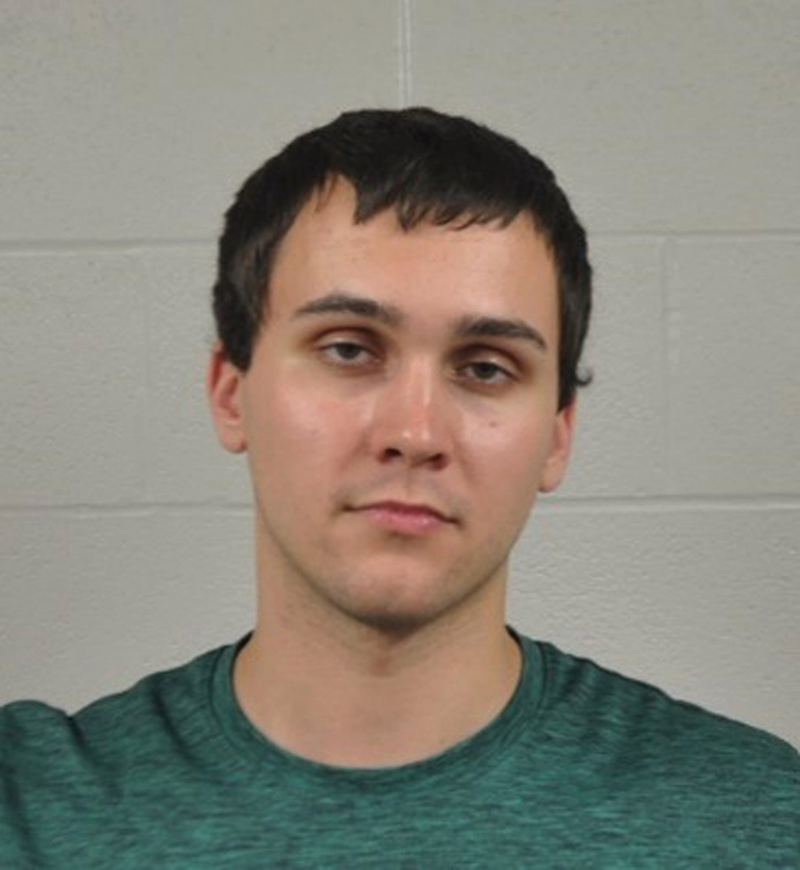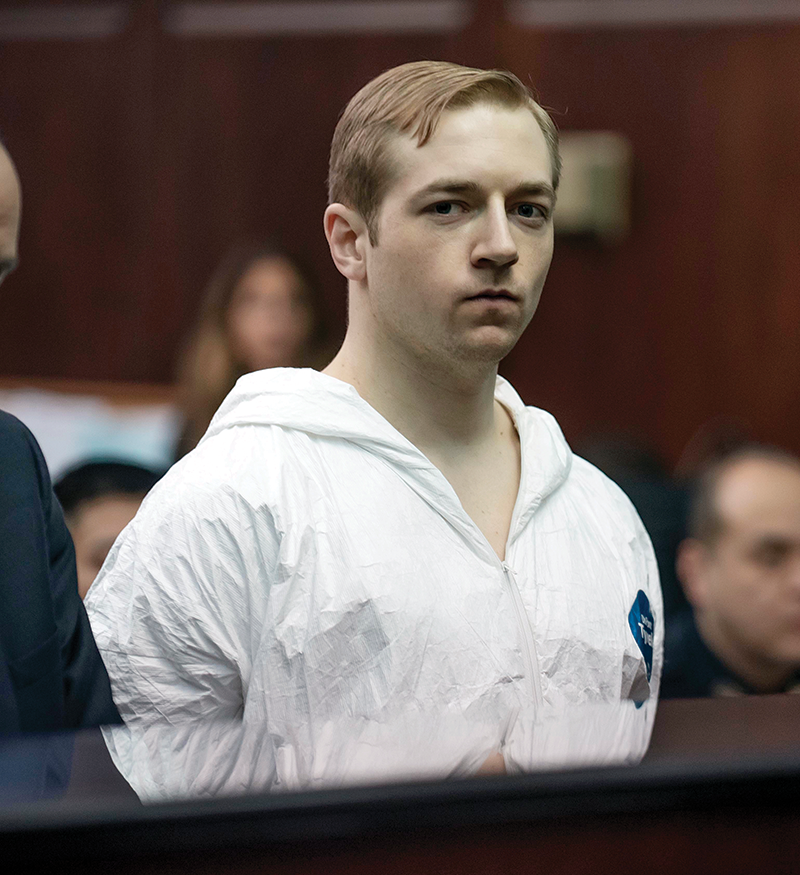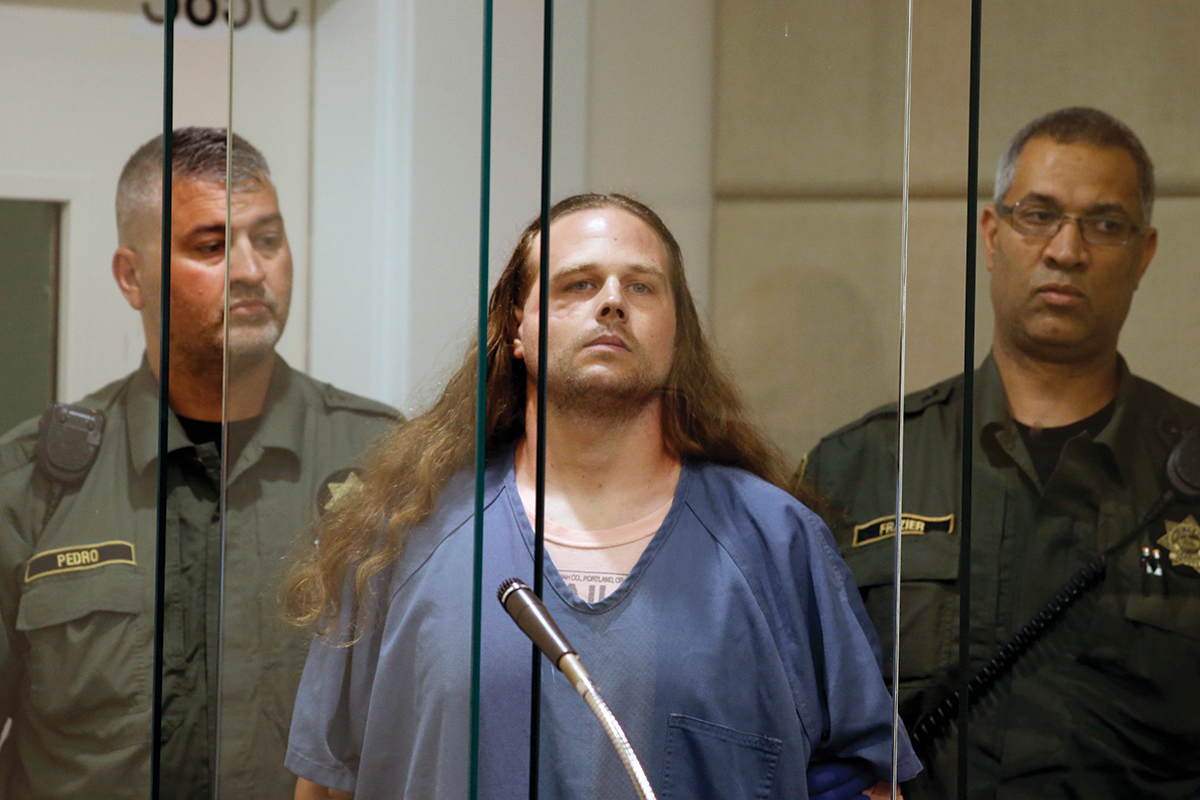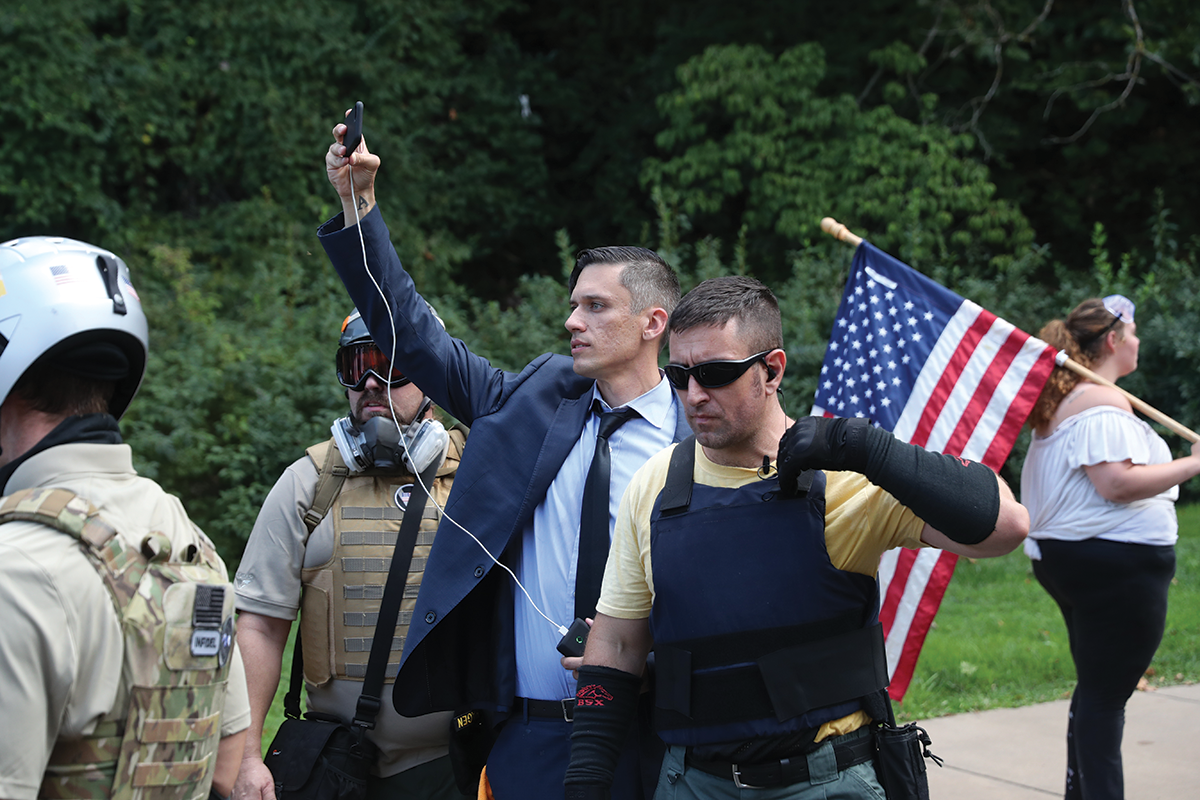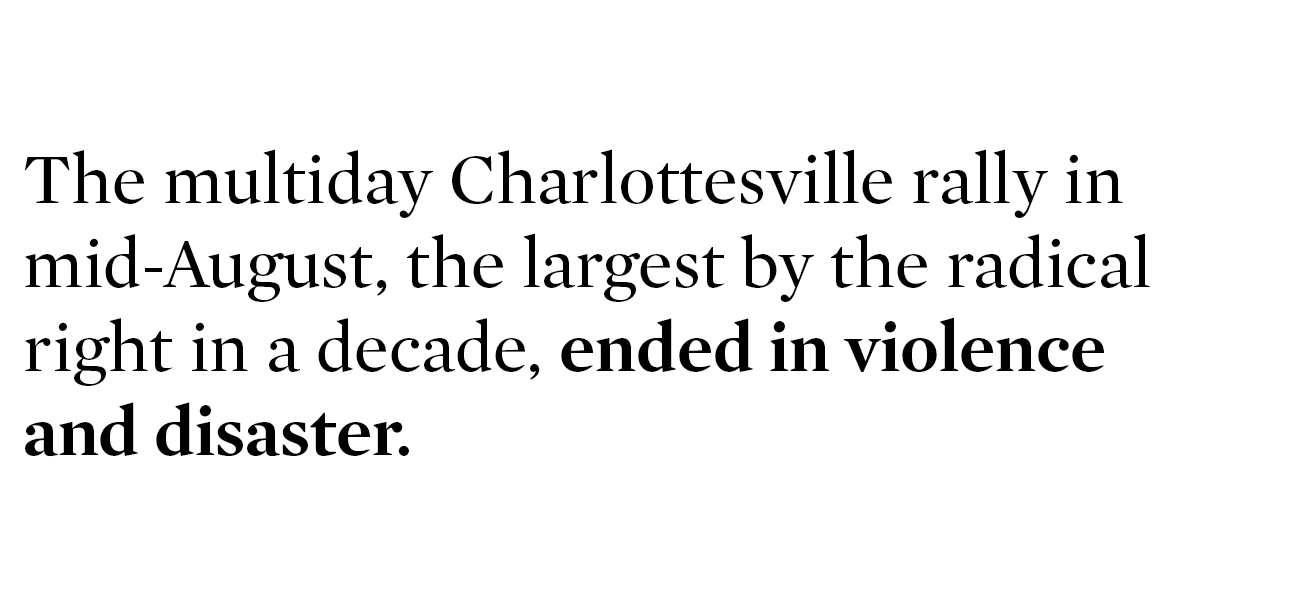2017: The Year in Hate and Extremism
The radical right started the year on a roll, with allies in the White House. But then came Charlottesville, and the movement was knocked back on its heels. Still, Trump's rhetoric and the country's changing demographics continue to buoy the movement.
If 2016 was the year of white supremacists being electrified by the rise of Donald Trump, his inauguration in January sent them into a frenzy. They believed they finally had a sympathizer in the White House and an administration that would enact policies to match their anti-immigrant, anti-Muslim and racist ideas.
Throughout the year, Trump thrilled and comforted them with his apparent kinship and pugilistic style, his refusal to condemn hate crimes committed in his name and his outrageous statements equating neo-Nazis and anti-racist activists after the deadly violence in Charlottesville.
Trump’s brand of nationalism wasn’t just a U.S. phenomenon. Far-right populist movements were on a global tear, first with Brexit in 2016 and then with nationalist parties seeing hefty gains in political power across Europe.
Polls made it clear that certain voters, particularly those uncomfortable with immigration and the demographic change that comes with it, supported Trump because of his racist views, even when they were not suffering from economic anxiety. This core of hard-right voters threw its support behind political candidates like the overtly pro-Confederate Corey Stewart, who nearly won Virginia’s GOP gubernatorial primary. In Alabama, Roy Moore, a rabidly anti-LGBT former state chief justice who has suggested that slavery was good for families, won the GOP nomination for U.S. Senate before losing a squeaker in the general election.
Trump may have faced dreadful approval ratings among all Americans, but he did not disappoint his adoring fans within the radical right.
In fact, he invited their white nationalism and bigotry into the White House. As key advisers, he hired extremists such as Steve Bannon — who boasted of transforming his website Breitbart News into “the platform for the alt-right” — and Sebastian Gorka, an infamous Muslim basher who, on the eve of Charlottesville, claimed that white supremacists are not “the problem” when it comes to terrorism. Hate group leaders like Tony Perkins of the anti-LGBT Family Research Council and Brigitte Gabriel of the anti-Muslim ACT for America were given the president’s ear. Trump moved quickly to enact policies sought by these groups and their allies. He ordered a ban on Muslims from overseas, for example, and barred transgender people from serving in our military. He instituted numerous anti-immigrant policies, such as allowing the Obama-era Deferred Action for Childhood Arrivals (DACA) program to expire, an act that threw the future of nearly 800,000 immigrants in limbo.
But the year did not continue on a high note for the white nationalist movement.
The multiday Charlottesville rally in mid-August, the largest by the radical right in a decade, ended in violence and disaster. Not only was an anti-racist protester killed by a white supremacist who rammed his car into a crowd, the movement as a whole was rebuked by public figures across the political spectrum and denounced in a unanimous, joint resolution by Congress. Perhaps worse for hate groups, their all-important online presence came under attack. Tech companies pulled PayPal accounts, took down websites and banned Twitter and Facebook accounts. Together, these moves greatly reduced the ability of extremists to spread demonizing propaganda to mainstream audiences and raise operating funds — at least for the time being.
The blowback from Charlottesville may have hit the white nationalist movement hard, but though they may be losing battles, they are having much more success in the war of ideas. A post-Charlottesville Washington Post/ABC News survey found that 9 percent of Americans — about 22 million people — thought it was fine to hold neo-Nazi or white supremacist views. And racists were reminded in January that they still have a sympathetic ear in the White House when Trump referred to Haiti and African countries as “shitholes.” Whatever the tactical losses the hate movement is suffering because of Charlottesville, the longer-term trend — in particular due to America’s changing demographics and Trump fanning xenophobic flames — will continue to fuel a white nationalist backlash in the coming years.
The Young and the Restless
As white nationalism mushroomed in Europe, the excitement resulted in the recruitment of more and more young people — not just millennials but also the even-younger Generation Z. They injected new life into an international movement that previously seemed stagnant and unappealing to angry internet warriors. In the United States, Trump’s win catapulted these young men from their keyboards into the streets, where they marched and rallied from coast to coast. Most notable was the deadly “Unite the Right” event in Charlottesville on August 12. It was so popular that even antigovernment militias, which usually shun hate group events, got into the act.
In 2017, being a white nationalist suddenly seemed hip. No longer was it just a movement made up of old men wearing Klan robes or swastika armbands. Now it was young men wearing “fashy” haircuts, khakis and polo shirts. Image and style became nearly as important as the message. And white nationalism — now rebranded as the “alt-right” — crept further into the mainstream than it had in decades.
Rabidly racist and antisemitic web forums like Andrew Anglin’s Daily Stormer drew huge numbers up until the Charlottesville rally, when the finally outraged tech world began to take down their platforms. In the summer of 2016, Daily Stormer averaged about 140,000 unique page views a month. By the eve of the Charlottesville rally in August 2017, that number had reached nearly 750,000. Similarly, the oldest hate site, Stormfront, gained nearly 30,000 new registered users in the first eight months of 2017, bringing its total to over 326,000.
This excitement translated into growth among the white supremacist groups most closely aligned with the new president. In 2017, completely new groups sprouted up: Patriot Front, the Fraternal Order of Alt Knights, Identity Dixie and others. Groups that latched onto Trump flourished. Identity Evropa went from one chapter in 2016 to 15 in 2017; The Right Stuff expanded from four chapters to 21 and spawned Identity Dixie; and Vanguard America grew from 12 to 25. New voices, like Mike Enoch, became players in the movement.
These groups brought their messages onto college campuses, with aggressive recruitment efforts, most notably by the white nationalist Identity Evropa. Richard Spencer, who gained notoriety for addressing a crowd of racists after Trump’s win — prompting a mass sieg heil when he shouted “Hail Victory! Hail Trump!” — launched a tumultuous, though limited, college tour that pushed white nationalism onto campuses and raised his status even further as a figurehead for young, white men looking for a face that mirrored their own dissatisfactions.
Like the year before, the hate movement was marked by considerable violence. According to the Center for the Study of Hate and Extremism at California State University at San Bernardino, hate crimes in the six largest U.S. cities were up 20 percent from 2016.
Most prominent was the car attack that killed Heather Heyer in Charlottesville. But there were many other victims of this emboldened movement. In February, police say a white man in Kansas went to a bar and shot two men from India, one fatally, after reportedly telling them to “get out of my country.” In March, James H. Jackson, a pro-Trump Daily Stormer reader, traveled from Baltimore to New York City to kill black men. Jackson allegedly killed one man before turning himself in, after which he was charged with terrorism. A black college student was stabbed to death May 20 at the University of Maryland. The alleged attacker, Sean Urbanski, was a member of a racist Facebook group called Alt-Reich. Six days later, police say Jeremy Christian, a fan of both Trump and Oklahoma City bomber Timothy McVeigh, stabbed two men to death on the MAX train in Portland, Oregon. The men had come to the aid of two young Muslim women who were being harassed by Christian.
According to the Extremist Crime Database, there were nine fatal far-right attacks in the United States in 2017. The number of attempted plots was much higher. In one such failed attack, which occurred on the same day Heather Heyer was killed, the FBI arrested a man in Oklahoma City who was attempting to detonate what he believed to be a 1,000-pound truck bomb outside a bank building. The accounting in the Extremist Crime Database also does not include the gruesome, late December shooting of a couple in Virginia by a neo-Nazi who was dating their daughter and frequented alt-right sites.
Hate by the Numbers
In 2017, the Southern Poverty Law Center (SPLC) found that the number of hate groups rose to 954 from 917 the prior year, up 4 percent. Within the white supremacist movement, neo-Nazi groups saw the greatest growth — soaring by 22 percent from 99 to 121. Anti-Muslim groups also rose for a third straight year. After tripling from 2015 to 2016, they grew by another 13 percent, from 101 chapters to 114 in 2017. Anti-immigrant groups also leapt, from 14 to 22 in 2017.
Overall, white supremacist groups experienced a net loss of one chapter, largely because Ku Klux Klan groups fell dramatically, from 130 to 72 in 2017. It’s clear that the new generation of white supremacists is rejecting the hooded movement that was founded after the Civil War.
As the Klan declined, however, new movements arose, including 28 chapters of neo-Völkisch groups that practice an ethnocentric brand of paganism and see themselves as descendants of a mythic, pan-European Germanic people fighting for the survival of the white race. Also, for the first time, the SPLC added two male supremacy groups to the hate list. The vilification of women by these groups makes them no different than hate groups that demean entire populations, such as the LGBT community, Muslims or Jews, based on their inherent characteristics.
Black nationalist groups make up a little over 20 percent of the total list. This sector has been growing for several years, and that growth continued in 2017. It increased from 193 to 233 chapters, a leap of about 20 percent. Typically antisemitic, anti-LGBT and anti-white, these groups are expanding in reaction to rising white supremacy and Trump’s emboldening of racists. “Mr. Trump is tearing away the skin of the onion of white civility,” said Nation of Islam leader Louis Farrakhan in a 2016 radio interview, adding that Trump’s election would land the country in the “abyss of hell.” The Trump administration’s sharp turn away from police reform and civil rights added fuel to the movement.
Importantly, the environment for the black nationalist groups is categorically different than those of white hate groups. Unlike the alt-right, whose champions found themselves in influential White House positions in 2017, black nationalists have little or no impact on mainstream politics and no defenders in high office. Given their proportion of the population, black people are also more than 10 times as likely to be victims of hate crimes than white people, according to the latest FBI statistics.
The antigovernment “Patriot” movement also rose about 10 percent in 2017, from 623 chapters to 689. Armed militias, which engage in paramilitary training and are part of the overall antigovernment count, rose about 65 percent, from 165 to 273 chapters. This movement benefited from both a newfound attachment to white supremacist elements of the alt-right and closer connections to far-right segments of the GOP. Criminal cases brought by the federal government against prominent members of this movement, in particular those involved in the 2014 Bundy Ranch standoff and the militia takeover of the Malheur National Wildlife Refuge in 2016, collapsed spectacularly in the past year.
The Charlottesville Reckoning
Until August 12, it was a euphoric year for most of the radical right. The ascension of Trump to the White House brought on a sense, however aspirational, that white supremacy was finding a firm foothold in mainstream American politics.
But the gathering in Charlottesville, which began triumphantly, marked a turning point. The largest white supremacist rally in at least a decade — one that brought together neo-Confederates, neo-Nazis, militiamen and other elements of a movement that is usually debilitated by infighting — resulted in considerable negative fallout. The movement was not helped by days of TV news coverage showing jarring images of young white men marching with torches and screaming “Jews will not replace us” in the lead-up to Heather Heyer’s murder.
Congress was aghast at the violence and Americans outraged by Trump’s bizarre claims of equivalence between racists and the counter-protesters who opposed them. Ultimately, even the movement’s hero in the White House seemed to turn against the racists, as Trump quietly signed a unanimous congressional joint resolution calling on him to do everything within his power to battle hate crimes and the rising numbers of hate groups. Within days of the Charlottesville rally, prominent alt-right allies Bannon and Gorka were ejected from the administration, and Attorney General Jeff Sessions began promising to vigorously prosecute hate crimes. It remains to be seen if Trump will live up to the resolution’s promises by taking concrete steps that could tamp down the growing white supremacist movement. But Congress now has a basis to hold his feet to the fire, given his signature on the joint resolution.
Change also came to Silicon Valley, which had allowed hate speech to fester and grow on mainstream internet platforms for years. In the weeks following the protests, the tech world seemed to wake up to the threats emanating from this movement. Suddenly, extremist sites were pushed off the web. PayPal accounts were deleted. And the great era of “deplatforming,” “shuttering” and “deranking” began. White supremacists grew skittish as rallies were canceled or sparsely attended. Many racists have now come to see Charlottesville as a disaster.
There is no question that the awakening of Silicon Valley has had an impact. Web traffic to deplatformed sites has fallen; racists kicked off mainstream platforms now preach only to the crazy choir on sites like Gab; and financial transactions have moved to bitcoin and other cryptocurrencies. It’s uncertain whether hate groups can harness cryptocurrencies to fund their activities. The net effect is a reduced capacity for spreading the kind of propaganda that fuels the movement and brings in new recruits.
What follows are more detailed looks at sectors of the radical right.

NEO-NAZIS
The number of neo-Nazi chapters grew by 22 — to 121 in 2017 — as young people flooded into the movement after imbibing its ideas online on gaming sites and mainstream platforms.
But, as is often the case on the radical right, infighting and tactical debates emerged following the ecstasy of Trump’s election.
After the Charlottesville violence, The Daily Stormer’s Anglin lectured its organizers and rank-and-file white supremacists about optics and strategy, declaring he would never organize a rally himself. On September 27, a frustrated Anglin said: “We’ve got all these bad optics, we’ve got this obese dead woman, we’ve given the media an easy narrative.” he later condemned a rally in Shelbyville, Tennessee, in late October, saying it made the movement look like idiotic thugs. He wrote, “I and many others criticized the look of the march, in particular the military-like 1980s-style costumes.”
These debates over public protests and attire continue to roil the movement as it competes for the next generation of recruits. Regardless, as Charlottesville proved, Hitler’s ideas remain deadly.

WHITE NATIONALISTS
Reckless energy, bickering and violence plagued the white nationalist movement in 2017. Six people with ties to the alt-right allegedly committed homicide. In all, their victims included six killed and another 20 wounded. Major rallies were held in Pikeville, Kentucky; New Orleans; Charlottesville, Virginia; and Shelbyville, Tennessee. Richard Spencer — the movement’s default leader, and its most vociferous — delivered speeches at Auburn University and the University of Florida as part of a strategy of targeting college campuses for easy publicity and access to young minds.
Spencer’s appearance at Auburn in April, which the university initially cancelled because of safety concerns, took place only after a U.S. district court in Montgomery, Alabama, issued an injunction forcing the university to allow him to speak. Facing the threat of similar legal action by white nationalist attorney Kyle Bristow, the University of Florida allowed Spencer to speak on campus six months later. Security for the event, which came after Charlottesville, cost the university an estimated $600,000.
Following a year of mostly online activism during the run-up to the 2016 presidential election, movement leaders made a conscious choice to increase public demonstrations and college recruitment efforts in 2017.
During his Florida speech, Spencer refused to acknowledge the role his rhetoric plays in inspiring violence from his followers, particularly the death of Heather Heyer at the Unite the Right rally. Rather than accept any responsibility, he called for justice for her accused killer. In a twist of fate that evening, three of his supporters were arrested in Gainesville for attempted homicide after one fired a shot at a group of counter-protesters following an argument at a bus stop.
As the year wore on, the white nationalist scene became more extreme ideologically, with groups such as the Traditionalist Worker Party and Vanguard America, once firmly rooted in an ideology based on the goal of establishing a white ethnostate, fully embracing neo-Nazism and “Blood and Soil” fascism. In addition to public demonstrations, groups such as Identity Evropa and the newly minted Patriot Front relied heavily on distributing fliers and dropping banners on college campuses, typically in the dead of night, as a form of activism designed to create camaraderie, drive press coverage and give the illusion of a much larger movement.

SKINHEADS
Compared to 2012, when racist skinhead groups hit an all-time high of 138 chapters, the movement today has all the energy of a fizzled-out bottle rocket.
The Intelligence Project documented just 71 active skinhead chapters last year.
The decline of Golden State Skinheads (GSS) over the past year is emblematic of this shift away from “boots and braces” organizations that have been eclipsed by the “alt-right.”
In late June 2016, as a roving, violent riot engulfed California’s state Capitol grounds, the collective focus of white supremacists worldwide trained on Sacramento and a small GSS crew.
In early March of 2017, the California Highway Patrol finally released a report recommending that 106 individuals be charged with 514 misdemeanors and 68 felonies in the Sacramento event. That same week, the first flashpoints of violence at far-right rallies in Berkeley, California, took place. Charlottesville was still five months away. At all of those rallies, racist skinheads were relegated to what has long been their role as “foot soldiers” of the race war.
Nearly two years after Sacramento, GSS, like much of the skinhead movement, has hardly been heard except for the arrests of two of its members. One, William Scott Planer, was arrested this past July in Colorado after he and another man were caught defacing Jewish facilities in Colorado Springs.
Young white men concerned about future opportunities are lining up with Richard Spencer and Identity Evropa at neo-Nazi hubs like the Daily Stormer and fraternizing with groups like Matthew Heimbach’s Traditionalist Worker Party. As a result, the skinhead movement is shrinking, but those who remain are among the most fervent believers — men, mostly, whose tattooed fists clench knives and yearn to use them.
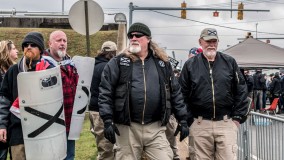
NEO-CONFEDERATES
While the number of active neo-Confederate groups declined in 2017, the drop belies an unprecedented level of militancy and media exposure of the ideology’s main practitioners, the League of the South (LOS) and its members. The LOS attempted to capitalize on the political turmoil wrought by the 2016 election and work aggressively to preserve Confederate monuments and other publicly supported memorials to white supremacy in the South. A resulting string of arrests came as LOS members and their neo-Nazi Nationalist Front pals, poised and trained for battle in a race war they believe is inevitable, increasingly took to the streets in populated and politically hostile areas.
As the LOS wholly abandoned attempts to brand itself as an organization composed of genteel Southern academics and dedicated to peacefully preserving testaments to “Southern heritage,” many longtime members distanced themselves from what has become a violent paramilitary outfit. In spite of the subsequent shuttering of many longstanding chapters in states like North Carolina and Georgia, several new chapters cropped up in Florida and Tennessee, two states that have been hotbeds of LOS activity.
The Nationalist Front faction — commanded by Michael Tubbs, the League’s chief of staff and its Florida chairman — initiated some of the worst violence at the disastrous Unite the Right rally. The Tennessee chapters were particularly active in the latter months of 2017 due to the efforts of a small group of activists closely allied with Matthew Heimbach’s neo-Nazi Traditionalist Worker Party.

KU KLUX KLAN GROUPS
As the oldest hate group in the United States, the Ku Klux Klan has reinvented itself many times over the past 150 years, but it seems now to have hit a wall, unable to adapt to the modern world and the changing tactics of the radical right. With no central organizational structure and feeble online activism, Klan groups have been unsuccessful in challenging the surging membership of the clean-cut, racist “alt-right.” And its rigidness has been the impetus for infighting.
While the number of active umbrella organizations changed little from 2016 to 2017, most saw a decline in the number of state or local chapters. The withering enthusiasm is reflected in an overall decline of 58 chapters.
Fractures within the Klan’s ranks were on display during several poorly attended events throughout the year. A June 10 protest against Sharia law in Stuart, Virginia, drew less than 15 members of the Rebel Brigade Knights and the Confederate White Knights. The following day, in Florence, Alabama, only 10 members of the Global Crusader Knights, the Exalted Knights and the International Keystone Knights showed up to protest the town’s pride parade.
Despite the lack of structure and stability, the Klan and its members remain capable of violence. The imperial wizard of the Confederate White Knights, Richard Preston, allegedly fired his gun at a black counter-protester while yelling racist slurs during the Charlottesville protests. Such hate-fueled violence is at the very core of the Klan’s ideology. With Preston’s trial set to begin on May 9, members of various Klan groups have initiated an effort to raise funds for his legal defense.
ANTI-IMMIGRANT GROUPS
“Getting out of bed these days is a lot more fun than it used to be. I’m having the time of my life.” These words of Dan Stein, president of the hate group Federation for American Immigration Reform (FAIR), reflect the nativist movement’s gleeful mood in 2017. With the arrival of Trump, the movement now has close allies in the White House, the U.S. Justice Department and the Department of Homeland Security. At the state and local level, emboldened nativist groups ramped up their advocacy efforts, and dormant figures resurfaced, revitalized by Trump’s election.
Due to the creation of new groups and the bolstering of extremism in those already established, the number of anti-immigrant hate groups grew from 14 in 2016 to 22 in 2017. And the movement’s “big three” Beltway organizations — FAIR, the Center for Immigration Studies (CIS) and NumbersUSA — have provided the blueprint for Trump’s nativist agenda. CIS testified before Congress four times in 2017, despite a joint SPLC-Center for New Community investigation that found that over the past 10 years, the group circulated white nationalist material via email more than 2,000 times.
The influence of FAIR and other nativist hate groups on Trump is clear. Through executive actions, he has revved up the deportation machine, turning loose the agents of Immigrations and Customs Enforcement to pursue not just suspected criminals among the undocumented but ordinary families. He has declined to renew DACA, the Obama-era program that protected some 700,000 young people brought to this country as children. He has called on Congress to end “chain migration,” a derogatory term used by nativist groups to describe policies intended to reunify immigrant families. He has announced he would end the temporary legal status for 46,000 Haitians and some 200,000 Salvadorans — refugees who arrived here after earthquakes hit their countries in 2010 and 2001, respectively. And, he continued to verbally demean immigrants of color, like in January 2018 when, during a meeting with members of Congress, he questioned why the country accepted immigrants from the “shithole countries” of Africa.
The administration also has joined the efforts of state and local anti-immigrant groups to end so-called “sanctuary cities” that have declined to use local law enforcement to enforce federal immigration laws. Efforts are underway in Oregon, California, Nevada and in the city of Boston.
Exhilarated by the turn of events, some extremists who had left the nativist movement have popped back up. Joseph Turner, a white nationalist fired by FAIR a decade ago after the SPLC exposed his racist views, resurfaced in 2017 and formed American Children First, a group dedicated to barring undocumented children from schools in California. Turner told The Los Angeles Times in April that he was “reinvigorated” by Trump.

ANTI-MUSLIM GROUPS
The number of anti-Muslim hate groups in the United States has steadily increased for the past few years, reaching its highest level in 2017 with 114 chapters. As it has grown, its connections to more hardline racist groups have also grown stronger.
At the federal level, rabidly anti-Muslim figures, most notably Sebastian Gorka, were given positions at the White House and other executive branch agencies. High-profile figures associated with the hate group ACT for America landed in positions where they were able to influence White House policy, such as the Muslim travel ban. Michael Flynn, an ACT advisory board member, became Trump’s short-lived national security adviser, while ACT’s founder and president, Brigitte Gabriel, spent an entire day meeting with officials at the White House in late March.
During 2017, 13 states introduced 14 anti-Sharia bills, with Texas and Arkansas enacting legislation. In addition, anti-Muslim activity and its intensifying overlap with other extremist movements resulted in the June 10 anti-Muslim rallies in 28 cities across the nation. In the months preceding the planned rallies, ACT struggled to control neo-Nazis and other extremists joining its ranks.

ANTI-LGBT GROUPS
Perhaps the biggest winners in terms of policy from Trump’s election have been hardline anti-LGBT groups that now have nearly unfettered access to, and sympathy from, the Trump administration. Though Trump promised during the campaign to be a “real friend” to the LGBT community, the administration has instituted a wide range of discriminatory policies, including some that roll back protections put in place under Obama.
In October, Trump became the first sitting president to address the annual Values Voter Summit, which was sponsored by a host of anti-LGBT groups and led by the Family Research Council (FRC). Trump has remained unwaveringly supportive of his conservative evangelical base as he implements anti-LGBT policies sought for years by groups like the FRC.
The changes began in February 2017 with the revocation of Obama-era federal guidelines specifying that transgender students have the right to use public school restrooms that match their gender identity. Since then, several other government agencies have quietly removed protections for, and services to, LGBT people. Trump attempted to ban transgender people from serving in the military. The DOJ submitted an amicus brief to the U.S. Supreme Court in support of a Colorado baker who is asserting the right to deny service to LGBT people based on religious belief.
Among the Senate-confirmed judges is attorney John Bush, a Trump supporter who has compared abortion to slavery, spread anti-Obama conspiracy theories and ranted about liberal politics under a pseudonym on a blog. Another confirmed judge is Steve Grasz, rated “unqualified” by the American Bar Association, which stated that Grasz’s “passionately held social agenda appeared to overwhelm and obscure [his] ability to exercise dispassionate and unbiased judgment.” The Trump administration is quietly pushing through others who could endanger LGBT rights for generations, all with the seal of approval and input from anti-LGBT hate groups and their allies.

BLACK NATIONALISTS
Trump not only energized white supremacists, he provoked a backlash among the Nation of Islam and other fringe black nationalist groups that see in him a powerful reassertion of the same centuries-old racism that has always fueled their desire to break away from white America. The white hate rallies, Trump’s hostility to civil rights, and the administration’s decision to abandon police reform all provided plenty of recruitment fodder.
Nation of Islam leader Louis Farrakhan pointed to Trump as the avatar of today’s white supremacy, blaming the president for encouraging a “growing sentiment” to “put the Black, the Brown, the Red back in a place they have cut out for us.” He unleashed wild claims about the federal government — that it was turning black men homosexual and plotting to kill him and his members. But he was optimistic: “The white man is going down, the time to rule is up.” Farrakhan’s newspaper, The Final Call, wrote that “separation from White America” is the “divine solution” to the rise of white supremacy.
Not surprisingly, given the environment, the ranks of black nationalist hate groups — groups that have always been a reaction to white racism — expanded to 233 chapters in 2017, from 193 the previous year. These groups, typified by anti-Semitic, anti-LGBT, anti-white rhetoric and conspiracy theories, should not be confused with mainstream black activist groups such as Black Lives Matter that work to eliminate systemic racism in American society.
Even with the growth, black nationalist groups lagged far behind the more than 600 groups that adhere to some form of white supremacist ideology. And, unlike white hate groups, they have made no inroads into the mainstream political realm and have virtually no supporters among elected officials — and certainly no supporters in the White House.
The Nation of Islam wasn’t the only group active in 2016. The New Black Panther Party staged multiple demonstrations in Mississippi and Louisiana. On July 5, members started a near riot while protesting the death of Alton Sterling. A different group, the New Black Panther Party for Self Defense, worked closely with its rabidly antisemitic former chairman, Malik Shabazz, who has blamed “the Jews” for the Federal Reserve and the corruption of Hollywood.
The Revolutionary Black Panther Party staged an armed anti-police march in Wisconsin where members chanted “f*ck the pigs” and “free us or you die, cracker!” They also perpetuated conspiracy theories online about the Orlando Pulse nightclub shooting being an inside job meant to promote homosexuality.

ANTIGOVERNMENT “PATRIOT” GROUPS
Toward the end of 2016, the antigovernment movement was readying for “civil war” in the event of a Hillary Clinton presidency. Just a few months later, the movement had to reconcile its antigovernment ideology with its widespread support for Donald Trump.
A spate of protests in liberal cities following the election allowed the militia movement, part of the larger antigovernment sector, to thrust itself into the spotlight of urban America in a significant way for the first time since the Oath Keepers deployed militants to protect mostly white-owned businesses in Ferguson, Missouri, in 2015. Piggybacking on hard-right rallies organized in blue cities across the nation, militias sought to capture public attention and put their training to the test. They hoped that the public exposure and their attempts to work cooperatively with police would lend legitimacy to their cause and shake the movement’s extremist image. In Oregon, that state’s GOP moved to have militias provide security for its events.
Unite the Right attracted a network of militia members under the command of the Pennsylvania Light Foot Militia.
Alex Michael Ramos, a former militiaman with the Georgia Security Force Three Percent, led by Chris “General Bloodagent” Hill, attended the rally and was arrested in connection to the brutal gang-style beating of DeAndre Harris, a black male who protested the white supremacist rally.
Ramos’ arrest marks the second time in two years that individuals with connections to Chris Hill’s Three Percenter organization were linked to racist or ethnically based violence — the first known instance took place in 2016 when a splinter of the Kansas Three Percent Security Force plotted to commit mass murder of Muslims and people of Somali descent in Garden City, Kansas.
At the same time, some antigovernment groups grew closer to hate groups. In 2017, Oath Keepers were asked by the anti-Muslim Act for America to provide security at June 10 rallies that took place in 28 cities across the country. Oath Keepers founder and president, Stewart Rhodes, responded by putting out a “call to action” endorsing the events and asking his followers to go and “protect free speech.” Rhodes and a gathering of Oath Keepers attended one of the events in Dallas, Texas, with long guns and tactical gear; other Oath Keepers appeared at many rallies around the country.
Historically, the SPLC has found that antigovernment activity and membership has risen sharply when Democrats take the presidency, as fears of gun grabs and federal action against such groups surges, and decline during Republican administrations, when such fears abate. That doesn’t seem to be the case with Trump in the White House, as the movement appears to be growing instead of shrinking, or at least treading water. Perhaps Trump’s radical views and bigotry are having an energizing effect on antigovernment groups, drawing them into politics in the same way that he has emboldened white supremacists and others in the hate movement. Their growing collaboration with anti-Muslim groups in particular shows that their concerns have moved far beyond guns in the past years.
Contributors to this story include Alex Amend, Stephen Piggott, Keegan Hankes and Rachel Janik




